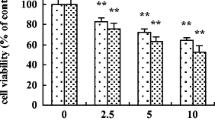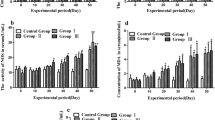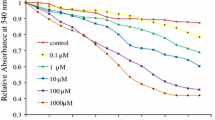In order to clarify the protective mechanism of sodium molybdate against the acute toxicity of cadmium chloride in rat, the effect of in vivo sodium molybdate pretreatment on the cytotoxic action of cadmium in isolated hepatocytes was studied. The cytosolic pH of hepatocytes isolated from untreated rats immediately decreased with incubation in either neutral Hank's balanced salt solution (HBS), pH 7.4, containing 5 µM cadmium chloride minimum or acidic HBS (pH 7.1, 6.8, 6.5, and 6.2). The presence of 5 µM cadmium in HBS adjusted to pH 7.1 aggravated cytosalic acidification induced by the acidic medium alone. Cell viability of hepatocytes incubated in HBS at pH 6.2 was significantly reduced as compared to that of control cells in HBS at pH 7.4, but the presence of cadmium in the acidic HBS had no aggravating action against such a toxic action of the acidic medium although cellular uptake of the metal in the medium increased, as compared to that in HBS at pH 7.4. Molybdenum pretreatment alleviated cytoplasmic acidification induced by the treatment with HBS at pH 7.4 or 7.1 containing cadmium or by extracellular acid load wothout cadmium. This pretreatment also prevented the loss of cell viability induced by the treatment with HBS at pH 6.2 but could not attenuate that when cadmium was present in the medium.
These facts suggest that molybdenum pretreatment alleviated the acute toxicity of cadmium in rat by preventing cytoplasmic acidification caused by the harmful metal.
Similar content being viewed by others
References
ANKE, M., GRUM, M., PARTSCHEFELD. M., GROPPE, B., and HENNIG, A. (1977). “Molybdenum deficiency in ruminants.” Trace Elem. Metab. Man and Anim. Proc. Int. Symp. 3rd p. 230.
BABCOCK, D.F. (1983). “Examination of the intracellular ionic environment and of ionophore action by null point measurement employing the flourescein chromophore.” J. Biol. Chem. 258: 6380–6389.
CHAILLET, J.R., AMSLER. K., and BORON, W.F. (1986). “Optical measurements of intracellular pH in single LLCPK1 cells.” Proc. Natl. Acad. Sci. 83: 522–526.
COHEIN, C.H. and FRIDOVITCHI, I. (1971). “Hepatic sulfite oxidase, Purification and properties.” J. Biol. Chem. 246: 359–366.
DE RENZO, E.C., KALITA, E., HEYTLER, P., OLESON, J.J., HUTCHINGS, B.L., and WILLIAMS, J.H. (1953). “The nature of the xanthine oxidase factor.” J. Am. Chem. Soc. 75: 753.
DUDLEY, R.E., SVOBODA, D.J., and KLAASSEN, C.D. (1984). “Time course of cadmium-induced ultrastructual changes in rat liver.” Toxicol. Appl. Pharmacol. 76: 150–160.
FRELIN, C., VINGE, P., LADOUX, A., and LAZDUNSKY, M. (1988). “The regulation of the intracellular pH in cells from vertebrates.” Eur. J. Biochem. 174: 3–14.
FURGSUN, W.S., LEWIS, A.H., and WATSON, S.J. (1943). “The teart pastures of Somerest. I. The cause and cure of teartness.” J. Agric. Sci. Camd. 33: 44–51.
GRINSTEIN, S., COHEN, S., and ROTHSTEIN, A. (1985). “Chemical modification of the Na+/H+ exchanger of thymic lymphocyte. Inhibition by N-ethylmaleimide.” Biochim. Biophys. Acta. 812: 213–222.
GRINSTEIN, S., ROTIN, D., and MASON, M.J. (1989). “Na+/H+ exchanger and growth factor-induced cytosolic pH changes. Role in cellular proliferation.” Biochim. Biophys. Acta. 988: 73–97.
HILDEBRAND, C.E., GRIFFITH, J.K., TOBEY, R.A., WALTER, R.A., and NGEL, M.D. (1982). “Molecular mechnism of cadmium detoxificaiton in cadmium-resistant cultured cells: Role of metallothione and other inducible factor.” In: Biological roles of metallothionein. (E.C. Foulkes, ed.). Elsevier, North Holland. p. 279.
HOFFMAN, E.K. and SIMONSEN, L.O. (1989). “Membrane mechanism in volume and pH regulation in vertebrate cells.” Physiol. Rev. 69: 315–382.
HOFFMAN, E.O., COOK, J.A., DILUZIO, N.R., and COOVER, J.A. (1975). “The effects of acute cadmium administration in the liver and kidney of rat: light and electron microscopic studies.” Lab. Invest. 32: 655–664.
JOHNSON, J.L., WAUD, W.R., RAJAGOPALAN, K.V., DURAN, M., BEEMER, F.A., and WADMAN, S.K. (1980). “Inborn errors of molybdenum metabolism: combined deficiencies of sulfite oxidase and xanthine oxidase in a patient lacking the molybdenum cofactor.” Proc. Natl. Acad. Sci. 77: 3715–3719.
KOIZUMI, R. and TAMANE, Y. (1984). “Protective effect of molybdenum on the acute toxicity of mercuric chloride. II.” Chem. Pharm. Bull. (Tokyo) 32: 631–637.
KOIZUMI, T. and YAMANE, Y. (1988). “Protective effect of molybdenum on the acute toxicity of mercuric chloride. V. Enhancement of renal regeneration after exposure to HgCl2.” Chem. Biol. Interac. 67: 185–197.
KOIZUMI, T., SAITOO, S., and YAMANE, Y. (1984). “Effect of molybdenum on the acute toxicity of mercuric chloride. IV. Effect of molybdenum on mercury-mediated metallothionein mRNA induction.” Chem.-Biol. Interac. 51: 219–231.
KUROKI, M., TAKESHIGE, K., and MINAKAMI, S. (1989). “ATP-induced calcium mobilization in human neutrophils.” Biochim. Biophys. Acta. 1012: 103–106.
MADSHUS, I.H. (1988). “Regulation of intracellular pH in eukaryotic cells.” Biochem. J. 250: 1–8.
McDOWELL,E.M., NAGLE, R.B., ZALME, R.C., McNEILL, J.S., FLAMENBAUM, W., and TRUMP, B.F. (1976). “Studies on the pathophysiology of acute renal failure. Virchows Arch. B. Cell Pathol.” 22: 173–196.
MERALI, Z. and SINGHAL, R.L. (1981). Biochemistry of cadmium in mammals systems: pancreotoxic manifestation in Cadmium in environment. Part II. (J.O. Nriga, ed.). John Wiley and Son, New York, NY. p. 612.
MOSMAN, T. (1983). “Rapid colorimetric assay for cellular growth and survival: application to proliferation and cytotoxicity assays.” J. Immunol. Methods. 65: 55–63.
PANE, C.C. (1977). “Molydenum responsive syndromes in poultry.” Trace Elem. Metab. Man Anim; Proc. Int. Symp. 3rd. p. 150.
PHANEUF, S., BERTA, P., CASANOVA, J., and CAVADORE, J.C. (1987). “ATP stimulates inositol phosphates accumulation and calcium mobilization in a primary culture of rat aortic myocyte.” Biochim. Biophys. Acta. 143: 454–460.
POST, R.L. and SEN, A.K. (1967). “Sodium and Potassium stimulated ATPase.” Methods. Enzymol. 10: 762–768.
PUCEAT, M., CLEMENT, O., SCAMPS, F., and VASSORT, G. (1991). “Extracellular ATP-induced acidification lead to cytosolic calcium transient rise in single rat cardiac myocytes.” Biochem. J. 274: 55–62.
RAJAGOPALAN, K.V., FRIDOVITCHI, I., and HANDLER, P. (1962). “Hepatic aldehyde oxidase-I. Purification and properties.” J. Biol. Chem. 237: 922–928.
RENNER, E.L., LAKE, J.R., SCHARSCHMIDT, J.R., MEIR, P.J., ZIMMERLI, B. (1989). “Rat hepatocytes exhibit basolateral Na+/HCO3 cotransport.” J. Clin. Invest. 83: 1225–1235.
RENNER, E.L., RAKE, J.R., PERSICO, M., and SCHARSCHMIDT, J.R. (1990). “Na+-H+ exchange activity in rat hepatocytes: role in regulation of intracellular pH.” Am. J. Physiol. 256: G44-G50.
SMITH, J.B., DWYER, S.D., and SMITH, L. (1989). “Evidence for a cell surface receptor that cadmium stimulates and zinc antagonize.” J. Biol. Chem. 264: 7115–7118.
STACEY, N.H., CANTILONNA, L.R. JR.,and KLAASSEN, C.D. (1980). “Cadmium toxicity and lipid peroxidation in isolated rat hepatocytes.” Toxicol. Appl. Pharmacol. 53: 470–480.
STEIN, A.F., BRACKEN, W.M., and KLAASSEN, C.D. (1987). “Utilization of methionine as a sulfhydryl source for metallothionein synthesis in rat primary hepatocytes culture.” Toxicol. Appl. Pharmacol. 87: 276–283.
TANNOCK, I.F. and ROTIN, D. (1989). “Acid pH in tumors and its potential for therapeutic exploitation.” Cancer Res. 49: 4373–4384.
TONNESSEN, T.I., LUDT, J., SANDVIG, K., and OLSNES, S. (1987). “Bicarbonate/chloride antiport in Vero cells. I. Evidence for both sodium-linked and sodium-independent exchange.” J. Cell Physiol. 132: 183–191.
WEBB, M. (1979). “Interactions of cadmium with cellular components.” In: The chemistry, biochemistry and biology of cadmium. (M. Webb, ed.). Elsevier/North-Holland Biochemical Press, Amsterdam. p. 285.
WINSTON, P.W., HOFFMAN, L., and SMITH, W. (1973). “Increased weight loss in molybdenum-treated rats in cold.” Trace Substances Environ. Health. 7: 241–247.
YAMANE, Y. and KOIZUMI, T. (1982). “Protective effect of molybdenum on the acute toxicity of mercuric chloride.” Toxicol. Appl. Pharmacol. 65: 214–221.
YAMANE, Y., FUKUCHI, M., CHIKO, L.I., and KOIZUMI, T. (1990). “Protective effect of sodium molybdate against the acute toxicity of cadmium chloride.” Toxicology. 60: 235–243.
Author information
Authors and Affiliations
Rights and permissions
About this article
Cite this article
Koizumi, T., Yokota, T., Fukuchi, M. et al. Protective mechanism of sodium molybdate against the acute toxicity of cadmium in rats. II. Prevention of cytoplasmic acidification. Cell Biol Toxicol 7, 357–369 (1991). https://doi.org/10.1007/BF00124071
Received:
Accepted:
Issue Date:
DOI: https://doi.org/10.1007/BF00124071




